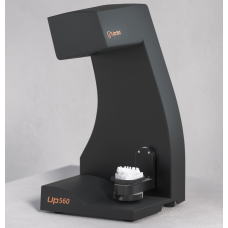UP3D prosthetic scanner UP560 + version with EXOCAD or UPCAD
Make an appointment for a free presentation in your studio/office:
Dental tech. Damian Dunajewski Consultant/CAD/CAM Specialist Tel.600 128 010 damian.dunajewski@mikran.com
Dental tech. Kamil Wolniewicz Consultant/CAD/CAM Specialist Tel.530 596 166 kamil.wolniewicz@mikran.com
Ultra-fast scanner with unrivaled accuracy with two 3.0 MP cameras that allow for efficient work and effective scanning:
- Traditional models.
- Split models.
- Models intended for wireframe work (scanning real textures)
- Models with kk (scan body) cartridges.
- Full arch models with implants in one scanning cycle.
- Impressions.
- Models placed in the articulator (Virtual Articulator)
- Models captured in hand-held occlusion
The UP560 scanner is the successor to the UP360+ model. The use of 2 independently operating cameras with a resolution of 3.0 MP and a high number of frames per second allows for faster capture of a much clearer image than cameras in competitive scanners with lower parameters. Placing cameras high above the model at an appropriate angle allows for effective scanning of models and impressions, even with undercuts, without "blind spots" and underscanned elements. The built-in automatic detection of the preparation boundary significantly speeds up the design process.
Parameters:
- Full arc scan: 15s
- Scanning 12 bars: 17s
- Impression scanning: 35s
- All-in-one 21s scanning
- Cameras: Dual 3.0MP (High Frequency)
- Automatic detection of the preparation border
- Accuracy: <6 microns
- Light: blue + multi color
- Interface: USB 3.0
The scanner can be purchased in 3 configurations:
- Only with scanning software.
- With EXOCAD scanning and design software.
- With scanning software and UPCAD design software.
COMMERCIAL INFORMATION/CONTACT:
Mikran.pl ul. Wojskowa 3/L4 60-792 Poznań sklep@mikran.pl, www.mikran.pl
Possibility of free presentation of the scanner in your workshop/office.
Call us: +48 600 128 010 or +48 530 596 166
Prosthetic scanners - a modern solution for prosthetic laboratories
Prosthetic scanners are devices that enable digital recording of the prosthetic field in the patient's oral cavity. Thanks to them, the dental technician can obtain an accurate 3D model of teeth, which can then be used to make a prosthetic restoration.
How does a prosthetic scanner work?
The prosthetic scanner uses cameras to take photos of teeth from all sides. Then, these photos are combined into one 3D model. The scanning process is quick and painless for the patient.
Types of prosthetic scanners
Prosthetic scanners can be divided into two main types:
- Intraoral scanners - are placed in the patient's mouth and take pictures of the teeth from all sides.
- Stationary extraoral scanners - thanks to advanced cameras, the scanner takes photos of the object from all sides, creating a perfectly reproduced 3D model.
Parameters of prosthetic scanners
When choosing a prosthetic scanner, the following parameters should be taken into account:
- Scanning accuracy - is given in microns. The higher the accuracy, the more precise the 3D model will be.
- Scanning Technology - Prosthetic scanners use various scanning technologies such as LED light or laser.
- Number and quality of cameras - the more cameras and the better their quality, the more accurate the 3D model will be.
- Software - prosthetic scanners are usually equipped with software for designing prosthetic restorations.
- Capabilities - Some prosthetic scanners allow scanning of various types of prosthetic work, such as crowns, bridges, dentures, etc.
- Scanning speed - scanning time depends on the size of the prosthetic field.
Advantages of prosthetic scanners
- Accuracy - prosthetic scanners allow you to obtain a very accurate 3D model.
- Convenience - the scanning process is quick and painless for the patient.
- Precision - prosthetic restorations made based on a 3D model are more precise than restorations made based on a traditional impression.
- Economics - prosthetic scanners can help reduce the cost of producing prosthetic restorations.
Summary
Prosthetic scanners are a modern solution that offers a number of advantages over traditional methods of making prosthetic restorations. They are increasingly used in prosthetic laboratories because they allow for more accurate and precise restorations.

